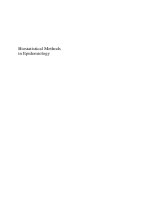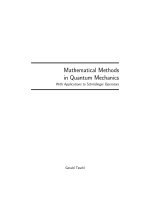ALTERNATIVE METHODS IN TOXICOLOGY TESTING
Bạn đang xem bản rút gọn của tài liệu. Xem và tải ngay bản đầy đủ của tài liệu tại đây (1.45 MB, 32 trang )
ALTERNATIVE METHODS IN
TOXICOLOGY TESTING
Thursday 8 December 2011
Herman Autrup
1
STRENGTHS AND WEAKNESS – PROS AND CONS:
ANIMAL TESTING AS A BASIS FOR RISK ASSESSMENT
Advantages
Considerable experience
Characterization of potency, target organs, type and time-
dependence of lesion development
Toxicokinetics covered (animals)
Disadvantages
Cost- and labor intensive
Completion of toxicity “package” may take up to 5 years
Use of large number of rodents/non-rodents
Need for extrapolation from animals to humans
Exposure assessment often imprecise, worst-case used
2
3R
Limit the use of animal experiments in toxicity
testing
Reduce
Refine
Replace
REACH regulation and EU cosmetic directives
3
Fixed Dose Procedure (FDP) — OECD TG 420. This method does not use death as an
endpoint, instead it uses the observation of clear signs of toxicity developed at one
of a series of fixed dose levels to estimate the LD50.
— Acute Toxic Class method (ATC) — OECD TG 423. This method does not use death
as the only endpoint, it also uses signs of toxicity in its stepwise approach to
estimating the LD50.
— Up-and-Down Procedure (UDP) — OECD TG 425. This method does still use death
as an endpoint, but doses animals one at a time to see if the dose needs to be put
up or down to achieve an estimate of the LD50 therefore giving the minimum
number of animals a lethal dose of the test substance.
REDUCE – LD50
4
REFINE – GENOTOXICITY STRATEGY
Tier 1 In vitro test, bacterial mutation, and in vitro
micronucleus, depends on specific features of test
compound
If both negative – non genotoxic
If one or more positive - in vivo tests
( erythrocyte nicronuclei, transgenic rodents assay, comet)
if one is positive – in vivo genotoxin
EFSA Journal 2011 9: 2379
5
REFINE – SENSITIVE ANIMALS
Transgenic mouse models –Carcinogen identification
+ car – car -noncar + noncar accuracy
Trp 53 +/- 21 10 27 1 81%
Tg/AC 17 6 29 10 74%
Ras H2 21 7 17 6 75%
NTP rat + genotox
36 0 7 23 65%
6
REPLACE
In vitro toxicological models
OECD- ECVAM
In silico
QSAR
7
IN VITRO TESTSYSTEMS
Acute systemic toxicity
Carcinogenicity
Dermal Penetration
Eye irritation/corrosion
Genotoxicity
Neurotoxicity
Pharmacokinetics & metabolism
Repeated Dose/organ toxicity
Reproductive development toxicity
Skin Irritation/corrosion
Skin sensitization
8
NEW APPROACHES TO TOXICITY TESTING
Toxicity testing in the 21
st
century (US NAS, 2007)
Advantages: attempt to comprehensively cover relevant molecular events,
high throughput prescreening, highly automated, expected to be rapid,
exposure driven ?
Disadvantages: What to do with false-positives/negatives, conflicting data ?
Do we know all relevant disease pathways ? Relation of pathway perturbation
(yes/no, 10 or 100 %) to in vivo toxicity ? Toxicokinetics not integrated in initial
approach !
Testing based on toxicity end-points in cell culture and integration
of toxicokinetics (several EU-funded projects)
Advantages: (attempted) integration of kinetics, biotransformation, effects
concentrations
Disadvantages: Relevance of response in a single cell type for effects on the
tissue/organ level? What is the best test system and test strategy
(combinations) ? Stability of cell culture systems ?
9
TOXICITY IN THE 21 CENTURY - CONCEPT
10
TOXICITY TESTING IN THE 21
ST
CENTURY I
Initial examination of the physicochemical properties and chemical
and biological fate of chemical
Toxicity testing which comprises two components: toxicity pathway
assays in which initial perturbations of relevant biological systems are
assessed followed by complementary targeted testing
Dose-response relationships involving three elements of extrapolation:
A quantitative mechanistic understanding of the relevant
mechanistic pathway
Physiologically-based kinetik modelling
Utilization of any suitable human data
Exposure data based on bio-monitoring and human surveillance data
11
TOXICITY TESTING IN THE 21
ST
CENTURY II
A wide range of in vitro test systems derived from human
tissues. The assumption here is that cells derived from humans
must be more representative of humans than other in vitro
systems
High throughput systems to detect biological changes caused by
exposure to the chemical under investigation, e.g. genomics and
enable their interpretation in terms of mechanisms
Rapid data processing systems and machine-learning systems to
deal with the large amount of data generated
Improvements in exposure assessment modeling using
information from a range of sources
In vivo models selected to address specific questions witch will
narrow uncertainties in the risk assessment, if needed
12
TESTING BASED ON TOXICITY END-POINTS IN CELL
CULTURE AND INTEGRATION OF TOXICOKINETICS
Characterization of
cytotoxicity of chemical
in “relevant” cell culture
model supported by
“omics” and other
molecular technics
Toxicokinetic modelling
to transform
concentration
responses seen in vitro
to dose-response in
animals/humans
Toxicity testing in cell culture
Concentration of drugs giving response for
sensitive and relevant endpoint
NOEC
Transformation of in vitro
concentrations to dose received by animal or
humans using
PBPK-modelling
Estimation of
NOAEL
MOS
Selection of drug candidates
Therapeutic dose level
(animal and/or human)
Interindividual
susceptibilities
13
Chemical Grouping in Toxicology
In SILICO TOXICOLOGY
14
OECD DEFINITION OF A CATEGORY
“ group of chemicals whose physico-
chemical and toxicological properties are
likely to be similar or follow a regular pattern
as a result of structural similarity ”
15
GROUPING COMPOUNDS TO FILL A DATA GAP
Form a rational group of compounds
Requires a transparent basis
Often termed a category
Obtain relevant toxicology, or other, data and
information for the group
Interpolate activity within the group
Read-across
Qualitative or occasionally quantitative
16
OECD (Q)SAR Application Toolbox
Helps the user group chemicals together and
perform read-across
It is not a predictive system
EU JRC Toxmatch
EU JRC Toxtree
US EPA Analogue Identification Methodology
Leadscope
Free(ish) Tools to Form Categories and
Perform Read-Across:
17
Mechanistic Analogues
O
O
O
OH
N
O
• Assumes reactivity relates to mechanism of
action
• Does not imply congeneric series: domains
defined by (mechanistic organic) chemistry
• Useful for mechanisms when we know there is
a “reactive mechanism of action”
•
Maybe qualitative or quantitative
Reactivity ≠ Activity
METHODS TO GROUP COMPOUNDS
18
Mode of Action (Receptor Mediated) Analogues
OH
OH
OH
OH
OH
METHODS TO GROUP COMPOUNDS
19
Mode of Action (Receptor Mediated) Analogues
OH
OH
OH
OH
OH
METHODS TO GROUP COMPOUNDS
•Useful for receptor mediated mechanisms
•Requires knowledge and definition of receptor binding
domain
•May be only feasible solution to some chronic endpoints
•Qualitative identification of hazard
20
Calculations of Similarity
METHODS TO GROUP COMPOUNDS
NH NH
OO
O
NH NH
OO
O
NH NH
OO
O
N NH
OO
O
NH NH
OO
O
NH NH
OO
O
NH NH
OO
N NH
OO
O
NH NH
OO
O
amobarbital
butabarbital
0.61
butalbital
0.70
mephobarbital
0.60
pentobarbital
0.71
phenobarbital
0.35
primidone
0.60
metharbital
0.68
0.66
secobarbital
1 = identical
0 = non-identical
Mechanism = activation of
GABAA receptor
Enoch SJ et al (2009) QSAR Comb. Sci. 28: 696-708.
21
IN SILICO TOXICITY – SKIN SENSITISATION
22
CRAMER RULES IN TOXTREE
The Cramer classification scheme is probably the best known approach for structuring chemicals in
order to estimate a Threshold of Toxicological Concern.
Chemicals are divided into three structural classes based on a decision tree. This comprises 33
structural rules and places evaluated compounds into one of three classes:
• Class I substances are simple chemical structures with efficient modes of metabolism suggesting a
low order of oral toxicity
• Class II are of intermediate toxicity
• Class III substances are those that permit no strong initial presumption of safety, or may even
suggest significant toxicity or have reactive functional groups
Cramer GM, Ford RA & Hall RL (1978). Estimation of Toxic Hazard - A Decision Tree Approach. J.
Cosmet. Toxicol., Vol.16, pp. 255-276, Pergamon Press.
23
CRAMER RULES IN TOXTREE
Yes branch in green. No branch in red.
Terminal nodes (labelled 1, 2 & 3) refer to Cramer classes I, II and III.
24
HYDROLYSIS REACTIONS IN TOXTREE
A limited number of hydrolysis reactions (Cramer rules #15, #17,
#29, #30 and #31) are implemented, based on expert advice
25









